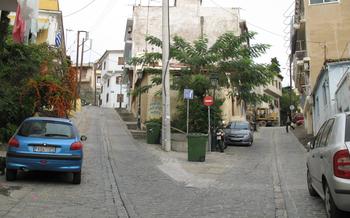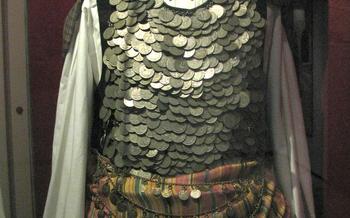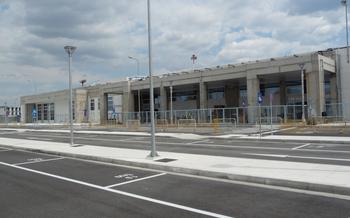
Vlatadon Monastery
- Vlatadon Monastery: A Byzantine Gem in Thessaloniki
- Immerse in History: A Journey Through Time
- Explore the Byzantine Architecture
- Key Features and Elements of Byzantine Design
- Comparison with Other Byzantine Monuments in Greece
- Symbolism and Hidden Meanings in the Architecture
- Admire the Stunning Frescoes
- Experience the Tranquility of the Courtyard
- Learn about the Monastic Life
- Attend a Divine Liturgy
- Enjoy the Panoramic City Views
- Participate in Cultural Events
- Take a Guided Tour
- Plan Your Visit
- Capture the Essence through Photography
- Respect the Sacred Space
Vlatadon Monastery: A Byzantine Gem in Thessaloniki
Nestled in the heart of Thessaloniki, Greece, the Vlatadon Monastery stands as a testament to the city's rich Byzantine heritage. Founded in the 14th century by the Byzantine aristocrat John Vlatades, the monastery holds immense historical and religious significance. Its well-preserved architecture, vibrant frescoes, and serene courtyard provide visitors with a glimpse into the spiritual and cultural world of the Byzantine era.
The Vlatadon Monastery is a true gem among Thessaloniki's many Byzantine monuments. Its architectural features, including the characteristic dome, arched windows, and intricate carvings, showcase the mastery of Byzantine builders. Unique characteristics, such as the two-story refectory and the underground cistern, further enhance the monastery's allure. Moreover, its contribution to the city's cultural heritage is undeniable, as it served as a center of learning and spirituality for centuries. The monastery's enduring legacy continues to inspire and captivate visitors from around the world.
Immerse in History: A Journey Through Time
The Vlatadon Monastery has witnessed numerous historical events that have shaped the city of Thessaloniki and the region. During the Byzantine period, it served as a center for religious and intellectual activity, contributing to the city's status as a major cultural hub. The monastery also played a significant role in the city's defense, withstanding numerous sieges and attacks.
In the Ottoman period, the monastery underwent significant changes. It was converted into a mosque and many of its original features were altered or destroyed. However, the monastery's significance as a religious and cultural landmark endured, and it continued to be a place of worship and learning for the local Christian community.
Today, the Vlatadon Monastery stands as a testament to the rich history and cultural heritage of Thessaloniki. It has undergone extensive restoration work to preserve its original Byzantine character, and it is now open to the public as a museum and cultural center. Visitors can explore the monastery's architecture, admire its stunning frescoes, and learn about its fascinating history.
Explore the Byzantine Architecture
Key Features and Elements of Byzantine Design
The Vlatadon Monastery stands as a testament to the grandeur and artistry of Byzantine architecture. Its design incorporates several key features that are characteristic of this architectural style. The monastery's exterior features a combination of brick and stone, creating a striking visual texture. The use of arches and domes is prevalent throughout the structure, adding to its aesthetic appeal and structural integrity. The interiors are adorned with intricate mosaics and frescoes, depicting biblical scenes and religious figures. These artistic elements not only enhance the beauty of the monastery but also serve as a means of religious storytelling and education.
Comparison with Other Byzantine Monuments in Greece
The Vlatadon Monastery shares similarities with other notable Byzantine monuments in Greece. Its architectural style bears resemblance to the Hagia Sophia in Istanbul, showcasing the influence of Byzantine architecture across the region. The use of domes and arches is a common feature in Byzantine churches and monasteries, providing a sense of spaciousness and grandeur. Additionally, the vibrant frescoes and mosaics found in the Vlatadon Monastery can be compared to those seen in other Byzantine monuments, such as the Church of the Holy Apostles in Thessaloniki.
Symbolism and Hidden Meanings in the Architecture
The architecture of the Vlatadon Monastery is not merely decorative but also holds symbolic and hidden meanings. The placement of the monastery on a hilltop represents its spiritual elevation and connection to the divine. The use of domes and arches symbolizes the heavens and the celestial realm. Furthermore, the intricate carvings and sculptures adorning the monastery's exterior and interior convey religious messages and stories, inviting viewers to contemplate their deeper significance.
Admire the Stunning Frescoes
The Vlatadon Monastery is a treasure trove of Byzantine art, with its walls adorned with vibrant frescoes that depict biblical scenes, saints, and symbolic representations. These frescoes are a testament to the skill and artistry of Byzantine craftsmen, who used a variety of techniques to create these stunning works of art.
The frescoes were created using the fresco technique, which involves painting on wet plaster. This technique allowed the colors to penetrate the plaster and become a permanent part of the wall. The artists used a variety of pigments, including natural earth pigments and crushed minerals, to create a rich and vibrant palette.
The frescoes in the Vlatadon Monastery depict a wide range of subjects, from biblical scenes to symbolic representations of theological concepts. Some of the most notable frescoes include the depiction of the Last Supper, the Crucifixion, and the Resurrection. The frescoes also feature a number of saints, including St. Demetrios, the patron saint of Thessaloniki, and St. Theodore.
The frescoes in the Vlatadon Monastery are not only beautiful works of art, but they also hold great religious and historical significance. They provide a glimpse into the beliefs and practices of the Byzantine Christians, and they offer a valuable record of the city's history.
The frescoes in the Vlatadon Monastery have been carefully preserved and restored over the centuries. Today, they stand as a testament to the enduring legacy of Byzantine art and the enduring faith of the Greek people.
Experience the Tranquility of the Courtyard
Step into the central courtyard of the Vlatadon Monastery, and you will be enveloped by an atmosphere of serenity and tranquility. Surrounded by beautifully preserved Byzantine architecture, this open space invites you to pause and reflect. The courtyard, with its carefully designed layout and lush greenery, serves as a symbolic representation of the inner peace and spiritual harmony sought by the monks who once resided here.
In the center of the courtyard, a serene fountain gently cascades, adding a soothing melody to the peaceful ambiance. The sound of trickling water blends harmoniously with the soft rustle of leaves, creating a symphony of tranquility. As you wander through the courtyard, take a moment to sit on one of the stone benches and let the serenity wash over you. Observe the intricate details of the surrounding architecture, and allow your mind to drift back in time, imagining the monks who once strolled these same paths, seeking solace and spiritual enlightenment within these sacred walls.
Learn about the Monastic Life
The Vlatadon Monastery offers a glimpse into the daily lives of Byzantine monks, providing insights into their traditions, rituals, and practices. Monks followed a strict routine of prayer, study, and work, adhering to the principles of humility, obedience, and self-sacrifice. They dedicated their lives to preserving religious and cultural heritage, transcribing manuscripts, and practicing iconography. The monastery served as a center of learning and scholarship, with monks engaging in theological discussions and producing significant works of literature. Their interaction with the local community was limited, but they played a crucial role in providing spiritual guidance and support. Visitors to the monastery can learn about the monks' way of life through guided tours, exhibits, and interactions with the resident monks, gaining a deeper understanding of the monastic tradition.
Attend a Divine Liturgy
Step into the sacred realm of the Vlatadon Monastery and immerse yourself in the awe-inspiring experience of a traditional Byzantine Divine Liturgy. This solemn and enchanting service, deeply rooted in Orthodox Christian tradition, transports you back in time, allowing you to witness the rituals and hymns that have been passed down through generations.
Feel the reverberations of the melodic chanting as the liturgy unfolds, enveloping the monastery's hallowed halls with a celestial aura. Observe the intricate symbolism and profound spirituality that permeate every aspect of the service, from the rhythmic movements of the priests to the flickering flames of the candles.
Open to visitors and non-Orthodox attendees alike, the Divine Liturgy at Vlatadon Monastery offers a unique opportunity to connect with the essence of Byzantine spirituality. Embrace the chance to witness this sacred ceremony, where faith, tradition, and history converge in a mesmerizing display of devotion.
Enjoy the Panoramic City Views
The Vlatadon Monastery offers breathtaking panoramic views of Thessaloniki and the Thermaic Gulf. From the elevated location of the monastery, visitors can capture stunning photos of the city's sprawling skyline, the azure waters of the gulf, and the verdant hills in the distance. The monastery's terrace provides an ideal spot to soak in the beauty of the surroundings, especially during sunset when the sky transforms into a canvas of vibrant colors. Whether you're a photography enthusiast or simply seeking a moment of tranquility, the panoramic views from the Vlatadon Monastery are not to be missed.
Participate in Cultural Events
The Vlatadon Monastery is not just a historical and religious site; it also serves as a vibrant cultural hub. Throughout the year, the monastery hosts a variety of cultural events that celebrate Byzantine art, history, and traditions. These events provide visitors with a unique opportunity to engage with local culture and experience the rich heritage of Thessaloniki.
From concerts and exhibitions to lectures and workshops, there is something for everyone at the Vlatadon Monastery. Music lovers can enjoy Byzantine chant concerts that transport them back in time, while art enthusiasts can admire exhibitions showcasing stunning Byzantine icons and mosaics. For those interested in delving deeper into Byzantine history and culture, lectures and workshops offer a wealth of knowledge and insights.
To stay up-to-date on upcoming events, visitors can check the monastery's website or social media pages. Booking tickets in advance is recommended, especially for popular events. Participating in cultural events at the Vlatadon Monastery is a wonderful way to immerse oneself in the city's Byzantine legacy and create lasting memories.
Take a Guided Tour
Enhance your visit to the Vlatadon Monastery by joining a guided tour. Guided tours are available in multiple languages, including English, French, German, and Greek. Professional guides offer in-depth insights into the monastery's history, architecture, and significance. They can point out hidden details, explain the symbolism behind the frescoes and mosaics, and share stories about the monks who lived here. Booking a tour is easy; you can reserve your spot online or at the monastery's ticket office. Choose a guide who is knowledgeable, passionate, and speaks your preferred language. Guided tours are a great way to make the most of your visit, especially if you have limited time or want to learn more about the monastery's rich history and cultural significance.
Plan Your Visit
To ensure a fulfilling experience, it's crucial to plan your visit to the Vlatadon Monastery. The monastery is generally open to the public daily, from morning until late afternoon. However, it's advisable to check the official website or contact the monastery directly for any updates or special arrangements. Admission to the monastery is free of charge, allowing visitors to explore its wonders without any financial constraints.
When planning your visit, consider the best time to avoid the crowds. The monastery tends to be less crowded during the weekdays and early mornings, offering a more serene and intimate experience. It's also worth noting that the monastery observes a dress code, so visitors should dress modestly and respectfully. Shorts, tank tops, and revealing clothing are discouraged.
Facilities for visitors are available on the premises, including restrooms and a small parking area. However, it's important to be mindful of the limited parking space and consider alternative transportation options if possible. The monastery's location within the city center makes it easily accessible by public transportation or on foot.
By planning your visit carefully, you can ensure a smooth and enriching experience at the Vlatadon Monastery, allowing you to fully immerse yourself in its history, architecture, and spiritual significance.
Capture the Essence through Photography
The Vlatadon Monastery offers a wealth of opportunities for photography enthusiasts. With its stunning architecture, vibrant frescoes, and serene courtyard, every corner of the monastery presents a picturesque subject. To capture the best shots, consider these tips:
-
Golden Hours: Aim to visit during the golden hours of sunrise or sunset when the warm light casts a magical glow on the monastery's facades.
-
Best Angles: For capturing the monastery's grandeur, position yourself in the central courtyard, allowing you to capture the full height of the domes and arches.
-
Interior Shots: While photography is generally permitted inside the monastery, always ask for permission before taking photos of the frescoes or during religious services.
-
Respectful Snapshots: Be mindful of other visitors and avoid using flash photography, which can be disruptive during services or while others are enjoying the tranquility of the monastery.
-
Share Your Experience: Share your stunning captures on social media, using hashtags like #VlatadonMonastery and tagging the monastery's official accounts. Your photos can help spread awareness of this hidden gem and inspire others to visit.
Respect the Sacred Space
As you step into the hallowed grounds of the Vlatadon Monastery, it is essential to remember that you are entering a sacred space that demands utmost respect. The monastery is an active religious institution, and the monks who reside here dedicate their lives to serving God and preserving Byzantine traditions. To ensure a harmonious and respectful visit, here are some guidelines to follow:
-
Maintain Silence and Minimize Distractions: During religious services, maintain silence and refrain from creating any disturbances. Avoid talking, laughing, or using electronic devices that may disrupt the solemn atmosphere.
-
Dress Modestly and Avoid Disruptive Activities: Dress modestly and appropriately when visiting the monastery. Avoid wearing revealing or disrespectful clothing. Refrain from engaging in loud conversations, running, or any other activities that may disturb the tranquil environment.
-
Show Respect for the Monks and Their Practices: The monks at the Vlatadon Monastery have dedicated their lives to serving God and preserving Byzantine traditions. Treat them with the utmost respect and courtesy. Do not interrupt their prayers or meditations, and refrain from asking intrusive questions about their personal lives or beliefs.
By following these guidelines, you will not only ensure a respectful and meaningful visit to the monastery but also contribute to preserving the sacredness and serenity of this Byzantine gem.





